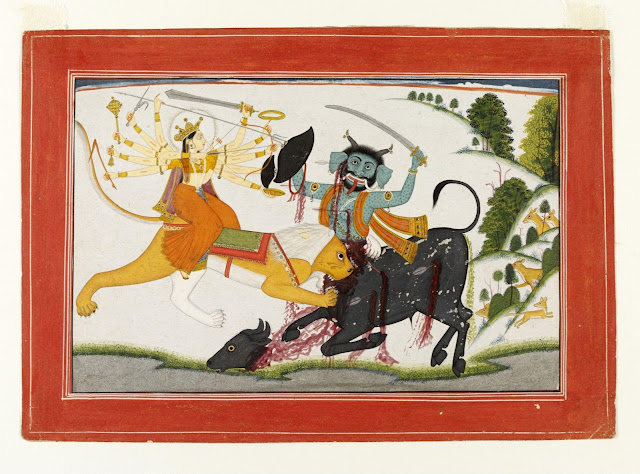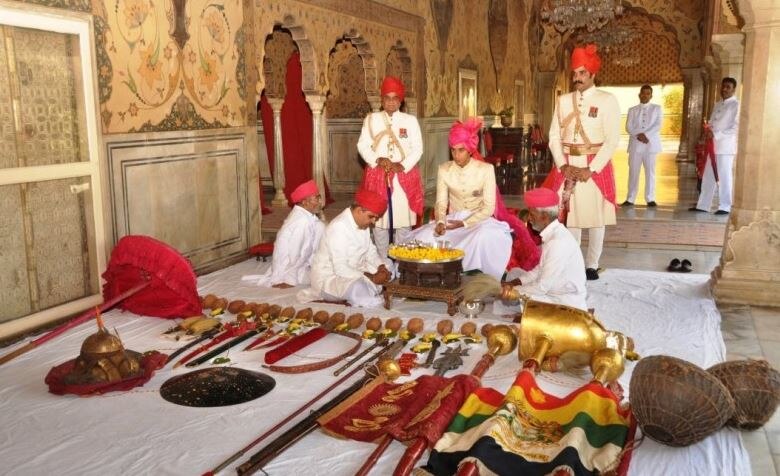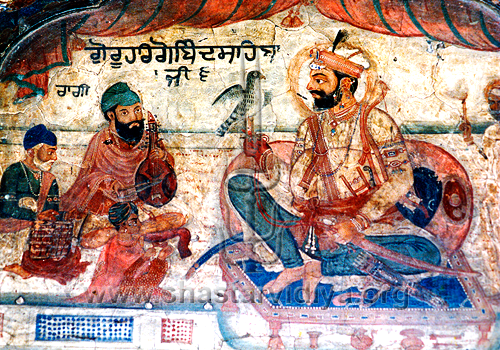Shakti's Authority in India - Two Traditions Show a Path of Dialogue
 |
| Durga Fighting Mahishasura, Nurpur Shaili ca 1760 (courtesy Victoria and Albert Museum) |
Ever so often there is so much noise about the power of the Divine Feminine, the Mother Goddess. Some generated veneration, while others generated debate and controversy. In the midst of all this has been lost the celebration of the Shakti, the Cosmic Force that drives the entire cosmos. That she is the progenitor of everything is perhaps why Shakti was visualised as The Mother, the Jagat Janani, the Jagat Amba among the Hindus. As the great revolutionary and thinker Sri Aurobindo had written in his pamphlet Bhawani Mandir:
The Shakti of war, the Shakti of wealth, the Shakti of Science are tenfold more mighty and colossal, a hundredfold more fierce, rapid and busy in their activity, a thousandfold more prolific in resources, weapons and instruments than ever before in recorded history. Everywhere the Mother is at work; from Her mighty and shaping hands enormous forms of Rakshasas, Asuras, Devas are leaping forth into the arena of the world. …Some are Mleccha Shaktis clouded in their strength, black or blood-crimson with tamas or rajas, others are Arya Shaktis, bathed in a pure flame of renunciation and utter self-sacrifice: but all are the Mother in Her new phase, remoulding, creating. She is pouring Her spirit into the old; She is whirling into life the new.
She has been seen in so many ways in so many schools of thought. From the leading and param pujaniya in the Shakta traditions of India, which remain popular to this day in the hill states of Northern India, to the Attukal Bhagavati of Kerala in whose honour Pongal is celebrated especially each year, there are forms and rituals that Indians of all hues adopted to venerate Her. Even in Trika Shaiva Advaita traditions of Kashmir, the followers venerate Shakti as the energy manifestation of Sadashiva, being the hidden power of all mantras. As the Spanda Nirnaya of the master Ksemaraja tells us:
सर्वं स्वात्मस्वरूपं मुकुरनगरवत्स्वस्वरूपात्स्वतन्त्र-
स्वच्छस्वात्मस्वभित्तौ कलयति धरणीतः शिवान्तं सदा या।
दृग्देवी मन्त्रवीर्यं सततसमुदिता शब्दराश्यात्मपूर्णा-
हन्तानन्तस्फुरत्ता जयति जगति सा शाङ्करी स्पन्दशक्तिः॥१॥
She, who is ever conscious of the vitality of mantra, who is the endless flash of the perfect and complete I-consciousness whose essence consists in a multitude of letters, who is the
goddess embodying jnana (knowledge), ever knows the totality of categories from the earth upto Siva, which is one in substance with Her own Self and is portrayed out of Her own nature on the canvas of Her own free, clear Self just as a city is reflected in a mirror (from which it is non-distinct). Hail to that Energy of creative pulsation (spandasakti) of Siva (Saipkari) that exults in glory all over the world. (Jaideva Singh’s translation)
This Devi has inspired people for long, giving strength and inspiration to people in many ways. As we see in the Durga Saptashati, Devi wields the sword of justice, thus linking Her spiritual side to the temporal world to restore balance in the universe. As was captured brilliantly in this piece a few days ago, we see repeated references to the Devi and Her sword of justice, wherein many of the asuras are slayed by Devi with Her sword. Such is the power of the sword that even the Devas sing its glory:
खड्गप्रभानिकर-विस्फुरणैस्तथोग्रः शूल ग्रकान्तिनिवहेन दृशोऽसुराणाम् ।
यन्नागताविलयमंशुमदिन्दुखण्ड यन्नाग्याननं तव विलोक्यतां तदेतत् ॥ (4.20)
If the intense light flashing frightfully from your sword or the glaring brilliance of your spearpoint did not blind the asuras’ eyes, it was because you made them behold the moonlike radiance beaming from your face (translation by Devadatta Kali).
Of course, this wielding of the sword as the sign of the Will of the Divine has precedents too in the Indic context. For instance, when we hear of Shivaji Maharaj and his Bhawani Talwar, we hear about him having been given the sword by Devi Tulja Bhawani herself. Legends as they be, this was definitely a sign of the temporal and the spiritual authority of the time. Even prior to Shivaji Maharaj, it was a fairly established practice in the Rajputs to carry two swords. As London based Asian antique arms and armour collector and dealer Runjeet Singh had noted in his booklet The Goddess: Arms & Armour of the Rajputs as follows:
To the Rajput and other Kshatriya races of India, the sword represents the Hindu Goddess of War herself. Often called Mata, or Mother, she can take on many forms, the most relevant of which is known as Durga. On one hand she lusts for destruction, while on the other she represents the primordial energy, or Shakti—the driving force of creation. Similarly, weapons too share this dual nature: desiring the blood, noise and fury of battle; yet also saving lives by providing protection and a means of defence.
 |
| Shastra Pujan in a Rajasthani Rajwada (courtesy: Zee News |
We see parallels to this trend even in the Khalsa panth and the Nihang traditions of Sikhs. References to the Devi and Her powerful sword find great resonance in the writings of Sri Guru Gobind Singh. While there has been much talk recently about Chandi Charitar Ukti Bilas, Chandi Charitar and Chandi Di Vaar, which get attributed to Sri Guru Gobind Singh ji, what is often underappreciated is the referencing to the stories of Devi and the detailing in it. In the Charitars, one finds extensive references to blood, gore and violence, and the weapon of choice for the Devi is the sword. For instance, in the Dasam Granth, the absolutely rhythmic section on the fight with Nisumbha features these lines among others:
ਤਾਗੜਦੰ ਤੀਰੰ ਬਾਗੜਦੰ ਬਾਣੰ ॥
ਕਾਗੜਦੰ ਕਾਤੀ ਕਟਾਰੀ ਕ੍ਰਿਪਾਣੰ ॥
ਨਾਗੜਦੰ ਨਾਦੰ ਬਾਗੜਦੰ ਬਾਜੇ ॥
ਸਾਗੜਦੰ ਸੂਰੰ ਰਾਗੜਦੰ ਰਾਜੇ ॥੪੦॥੧੧੭॥
The noises of the arrows and shafts, daggers and swords are being heard.
The music of the musical instruments and the drumming of the trumpets resounds and the warriors and chieftains are doing their job amidst such resonance.
 |
| At the Gurdwara Sri Nagina Ghaat, Takht Sachkhand Sri Hazoor Abchalnagar Sahib Nanded(courtesy: Herrai Singh) |
Similarly, in the Dasam Granth, we see the reference to the Bhagauti Astotar in the recension of the Dasam Granth published by the Nihang Budha Dal which talks about the sword of Bhagauti, identifying Bhagauti with the sword:
ਨਮੋ ਸ੍ਰੀ ਭਗੌਤੀ ਬਢੇਲੀ ਸਰੋਹੀ ॥ ਕਰੇਂ ਏਕ ਤੇ ਦ੍ਵੈ ਸੁਭਟ ਹਾਥ ਸੋਹੀ ॥
ਨਮੋ ਲੋਹ ਕੀ ਪੁਤ੍ਰਿਕਾ ਝਲ ਝਲੰਤੀ ॥ ਨਮੋ ਜੀਭ ਜ੍ਵਾਲਾਮੁਖੀ ਜਯੋ ਬਲੰਤੀ ॥
ਮਹਾਂ ਪਾਨ ਕੀ ਬਾਨ ਗੰਗਾ ਤਰੰਗੀ ॥ ਭਿਰੇ ਸਾਮੁਹੇ ਮੋਖ ਦਾਤੀ ਅਭੰਗੀ ॥
ਨਮੋ ਤੇਗ ਤਰਵਾਰ ਸ੍ਰੀ ਖੱਗ ਖੰਡਾ ॥ ਮਹਾਂ ਰੁਦ੍ਰ ਰੂਪਾ ਬਿਰੂਪਾ ਪ੍ਰਚੰਡਾ ॥
Salutations to the highest Sword, the cutting Sirohi [type of Sword]. Making two from one [decapitating], the warrior who holds You in their hand is victorious !
Salutations to the strip of iron which flashes so brightly ! Salutations to the One who spits fire from the mouth
In that great hand [which takes the sword], it moves like the River Ganga. The one who falls in front of you is granted salvation !
Salutations to the Tegh ! Talvaar ! The highest Khanda ! Ferocious and vicious both with and without form (translation as given on Manglacharan)
Of course, these traditions did not materialise with the Tenth Guru. the Sixth Guru of the Sikh tradition, Guru Hargobind ji, we see him carrying two swords of Miri and Piri, which refer to spiritual and temporal powers. However, given the Indic traditions of the two swords and their relation with Divinity, one could argue that the tradition had Indic roots, and was not necessarily an import as the phraseology used for the words would suggest and has also been argued by some people. This was a direct result of the formal introduction of the military aspect into the tradition, which was perhaps necessitated by a variety of political and social compulsions of the time. As captured well by Inderjeet Singh Bhatia in this piece on Guru Hargobind ji:
Guru Hargobind Ji’s succession ceremony took place on 24th of June1606, on that day, Bhai Budha Ji, the grand old man of the Sikh Brotherhood brought him ‘Seli’ the sacred headgear of renunciation that Guru Nanak wore and had bequeathed to his successors one after another. Guru Ji put it aside and asked for a sword instead. Bhai Budhaji, who had never handled a sword brought out one and put it on the wrong side. Guru Ji noticed it and then asked for another. “I will wear two swords” said Guruji, a Sword of “Shakti” (Power) and a sword of “Bhakti” (Meditation). Thus Guru Hargobind Ji combined in himself “Piri” (renunciation) and “Miri” (royalty).
 |
| Fresco of Sri Guru Hargobind ji (courtesy: Sanatan Shastar Vidiya) |
Clearly, the dialogue between two traditions has been going on for centuries now. This is not about praising one path or the other. Rather, it is about finding the commonalities that we so rarely discover these days, calling for deliberation and the need to remember that we all belong to this very bhoomi.

Comments